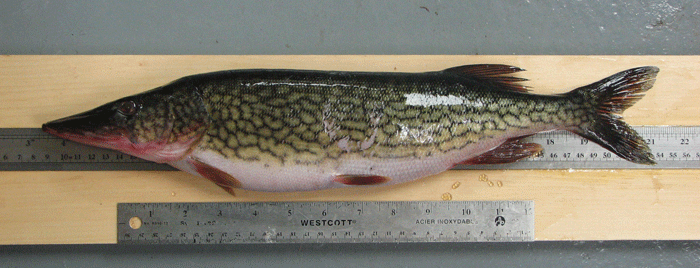Chain Pickerel Expanding into Ontario
The native range of this southern cousin of the Northern Pike is expanding into Ontario. On September 16, 2009, a MNR field crew identified a Chain Pickerel (Esox niger) captured during routine gill-netting operations in the Thousand Islands area of the upper St. Lawrence River. The fish was 58 cm long and weighed approximately 1.4 kg. This was the second documented occurrence of Chain Pickerel in this area in the last year and a half. A commercial fisherman turned in the first in April 2008. These two specimens represent possibly the first documented Chain Pickerel in the province.

Photo credit: Jim Hoyle
Elsewhere in Canada, the species occurs only in Nova Scotia (introduced from the United States), western New Brunswick, and the Eastern Townships of Quebec, south of the St. Lawrence River. The appearance of Chain Pickerel in the eastern Lake Ontario/upper St. Lawrence region might signal a northwest expansion of the species’ native range. Potentially, climate warming in this region of southern Ontario would favour persistence of such a range expansion. The Chain Pickerel is a member of the Pike (Esocidae) family and superficially resembles a Northern Pike. It can be identified by prominent chain-like markings on its head and sides, and some individuals have a prominent subocular bar or vertical stripe under the eye. The MNR is interested in hearing if anglers catch these fish in Lake Ontario and the St. Lawrence River. These fish are currently not abundant in Ontario, but if a range expansion is underway, the ministry is interested to see how it progresses. A photograph to help confirm identification would be ideal, as well as information on the location of capture and the size of the fish. Anglers can report their catch by calling the Glenora Fisheries Station at 613-476-2400. The Chain Pickerel is a desired sport fish in parts of its native range. For more information, search “Chain Pickerel” on the Ontario Freshwater Fishes Life History Database. (Original article published in Ontario OUT OF DOORS Volume 41, Issue 10, Winter 2009/2010; written by Jim Hoyle, Assessment Biologist with the MNR’s Lake Ontario Management Unit).


